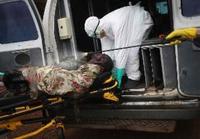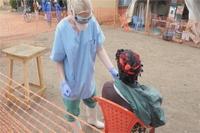-
Pre-empting flu evolution may make for better vaccines
Influenza is a notoriously difficult virus against which to vaccinate. There are many different strains circulating — both in human and animal populations — and these strains themselves evolve rapidly. Yet manufacturers, who need to produce around 350 million doses ahead of the annual flu season, must know which strain to put in the vaccine months in advance — during which time the circulating viruses can evolve again. An international team of researchers has shown that it may be possible to improve the effectiveness of the seasonal flu vaccine by “pre-empting” the evolution of the influenza virus.
-
-
Scientists identify weak spots in Ebola’s defenses
Scientists have identified weak spots on the surface of Ebola virus that are targeted by the antibodies in ZMapp, the experimental drug cocktail administered to several patients during the recent Ebola outbreak. “The structural images of Ebola virus are like enemy reconnaissance,” said one of the scientists involved in the research. “They tell us exactly where to target antibodies or drugs.”
-
-
U.S. will not see an Ebola epidemic – not even a serious outbreak: Scientists

Twenty-five years ago, the United States experienced its first Ebola outbreak in a Reston, Virginia primate facility which shipped animals to research labs throughout the country. Jerry Jaax, one of the scientists who worked at the primate facility at the time and who is now an associate vice president for research compliance and university veterinarian at Kansas State University, believes that the United States is well prepared to handle the Ebola virus. “We won’t have an epidemic or even a serious outbreak,” said Jerry Jaax. “The thing about it is we’ve got a zero risk tolerance bar that we set that says we can’t afford to have one person get infected or it’s a disaster. You can’t ever say never in biology and there are a lot of wild cards thrown in there, but I think basically the United States is ready.”
-
-
Ebola discussion in U.S. driven by fear, not science: Infectious disease experts
A significant part of the Ebola debate in the United States has been driven by fear, not science, according to infectious disease experts. Despite assurances from public health officials, the general public continues to be fearful of an Ebola outbreak in the United States. Some states have imposed mandatory quarantines for all healthcare workers returning from Ebola-stricken West Africa, even if they show no symptoms.”The fear is trumping science,” said Dr. Georges Benjamin, executive director of the American Public Health Association.
-
-
Searching for weapons in the fight against drug-resistant bacteria
Researchers are taking a very close look at bacterial cells in hopes of figuring out how to stop the spread of antibiotic-resistant bacteria known as CRE, or carbapenem-resistant Enterobacteriaceae. Dubbed the “nightmare bacteria,” CRE infections are immune to even the strongest antibiotics and have the ability to transfer that drug resistance to other bacteria. The infections, which can lead to pneumonia, sepsis, meningitis, and more, have a 50 percent mortality rate. “That’s worse than Ebola,” says one researcher.
-
-
Epidemics do not require long-distance travel by virus carriers to spread
The current Ebola outbreak shows how quickly diseases can spread with global jet travel. Yet knowing how to predict the spread of these epidemics is still uncertain, because the complicated models used are not fully understood. Using a very simple model of disease spread, UC Berkeley biophysicist Oskar Hallatschek proved that one common assumption is actually wrong. Most models have taken for granted that if disease vectors, such as humans, have any chance of “jumping” outside the initial outbreak area — by plane or train, for example – the outbreak quickly metastasizes into an epidemic. Hallatschek and colleagues found instead that if the chance of long-distance dispersal is low enough, the disease spreads quite slowly, like a wave rippling out from the initial outbreak. This type of spread was common centuries ago when humans rarely traveled. The Black Death spread through fourteenth-century Europe as a wave, for example.
-
-
Alternative to antibiotics
Ever since the development of penicillin almost ninety years ago, antibiotics have remained the gold standard in the treatment of bacterial infections. The World Health organization (WHO), however, has repeatedly warned of a growing emergence of bacteria that develop antibiotic resistance. Once antibiotics do no longer protect from bacterial infection, a mere pneumonia might be fatal. Scientists from the University of Bern have developed a novel substance for the treatment of severe bacterial infections without antibiotics, which would prevent the development of antibiotic resistance.
-
-
U.S. will see between 1 and 130 additional Ebola cases by end of 2014: Experts

Top U.S. medical experts studying the spread of Ebola predict a few more cases will reach America before year’s end, citing the return of healthcare workers currently working in West Africa as the most likely cause of new cases. Using data models that weigh several variables including daily new infections in West Africa, global airline traffic, and transmission possibilities, top infectious disease experts predict as few as one or two additional infections and as many as 130 by the end of 2014.
-
-
Rate of infection in West Africa has begun to slow down

Public health officials monitoring the Ebola epidemic in West Africa say the outbreak may have reached a turning point in which transmissions may have begun to slow down. Dr. Jeremy Farrar, director of the Wellcome Trust, the organization funding a series of fast-tracked trials of Ebola vaccines and drugs, says that although the virus will continue to infect people in the months ahead, “it is finally becoming possible to see some light.”
-
-
Infection outbreaks, unique diseases on the increase since 1980
Ebola has a lot of company. In a novel database now made publicly available, researchers found that since 1980 the world has seen an increasing number of infectious disease outbreaks from an increasing number of sources. The good news, however, is that they are affecting a shrinking proportion of the world population. The number of infectious disease outbreaks and the number of unique illnesses causing them appear to be increasing around the globe, with more than 12,000 outbreaks affecting forty-four million people worldwide over the last thirty-three years.
-
-
Lack of federal authority makes fashioning coherent national Ebola policy difficult

Earlier this week, the Centers for Disease Control and Prevention(CDC) issued new guidelines on how states should deal with travelers from Ebola-stricken regions, but a lack of federal authority to mandate such guidelines has led to conflicting strategies, varying from state to state, which includes mandatory at-home quarantine for some travelers. Under current U.S. law, the states have the authority to issue quarantine or isolation policies, and they also control the enforcement of these policies within their territories.
-
-
Infection projections: how the spread of Ebola is calculated
Ebola is an example of an emerging infectious disease (EID): one that has newly appeared in a population or has undergone a rapid increase in incidence. Bioinformatics plays a key role in detecting, monitoring and responding to EIDs. In the case of Ebola, the bioinformatics community has responded rapidly. For example, the current outbreak of Ebola in Sierra Leone was first detected in May, but by September a study reported sequencing 99 Ebola virus genomes from 78 patients diagnosed with the disease between late May and mid-June. Bioinformaticians have been developing and refining algorithms for sequence assembly since the late 1980s, and are constantly adapting them so they can handle new sequencing technologies and ever-larger scales of assembly. Bioinformatics is, and will continue to be, a core component of the international response to Ebola and other EIDs, and patients, medical staff and those close to them need all the help they can get.
-
-
Legality of mandatory quarantine of asymptomatic individuals questioned
Roughly three decades ago, patients in New York were forced into isolationafter an outbreak of tuberculosis, and about seventy years before that, an influenza pandemic led to mass quarantine in major American cities. Today, fear of an Ebola outbreak in the United States has led some states to mandate quarantine of individuals suspected of having the Ebola virus, but legal analysts question the legality of such measures.
-
-
Experts consider implications of Ebola strain being stolen from lab
As the Ebola virus continues to plague several Americans and Europeans and thousands in Africa, researchers are beginning to examine the outcomes should a strain of Ebola be stolen from a testing laboratory. Many scientists in U.S. labs study the Ebola virus in order to find out how they can fight it. They wonder, however, what set of procedures are in place if a sample of the virus was stolen.
-
-
Insurance companies now write Ebola exclusions into policies; offer Ebola-related products
U.S. and British insurance companies have begun to write Ebola exclusions into their policies for hospitals, event organizers, airliners, and other businesses vulnerable to disruption from the disease. As a result, new policies and renewals will become more expensive for firms looking to insure business travel to West Africa or to cover the risk of losses from Ebola-driven business interruptions (BI).The cost of insuring an event against Ebola, for example, would likely be triple the amount of normal cancellation insurance — if the venue was in a region not known to be affected by the virus.
-
- All
- Regional
- Water
- Biometrics
- Borders/Immig
- Business
- Cybersecurity
- Detection
- Disasters
- Government
- Infrastructure
- International
- Public health
- Public Safety
- Communication interoperabillity
- Emergency services
- Emergency medical services
- Fire
- First response
- IEDs
- Law Enforcement
- Law Enforcement Technology
- Military technology
- Nonlethal weapons
- Nuclear weapons
- Personal protection equipment
- Police
- Notification /alert systems
- Situational awareness
- Weapons systems
- Sci-Tech
- Sector Reports
- Surveillance
- Transportation
Advertising & Marketing: advertise@newswirepubs.com
Editorial: editor@newswirepubs.com
General: info@newswirepubs.com
2010-2011 © News Wire Publications, LLC News Wire Publications, LLC
220 Old Country Road | Suite 200 | Mineola | New York | 11501
Permissions and Policies
Editorial: editor@newswirepubs.com
General: info@newswirepubs.com
2010-2011 © News Wire Publications, LLC News Wire Publications, LLC
220 Old Country Road | Suite 200 | Mineola | New York | 11501
Permissions and Policies
